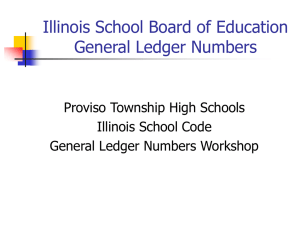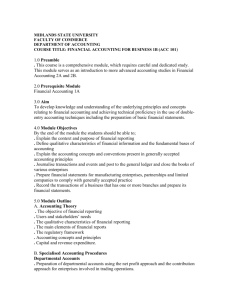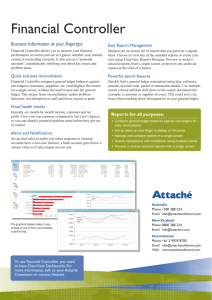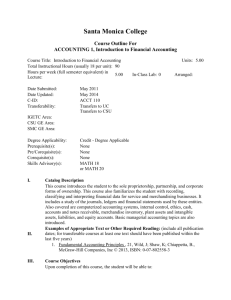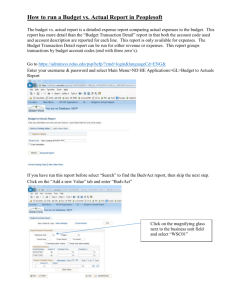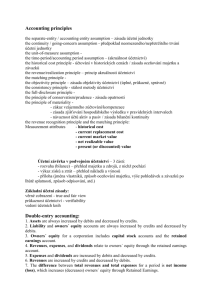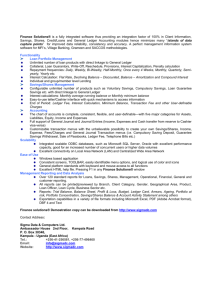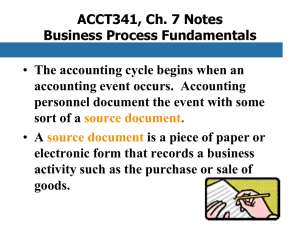Accounting Vocabulary
advertisement
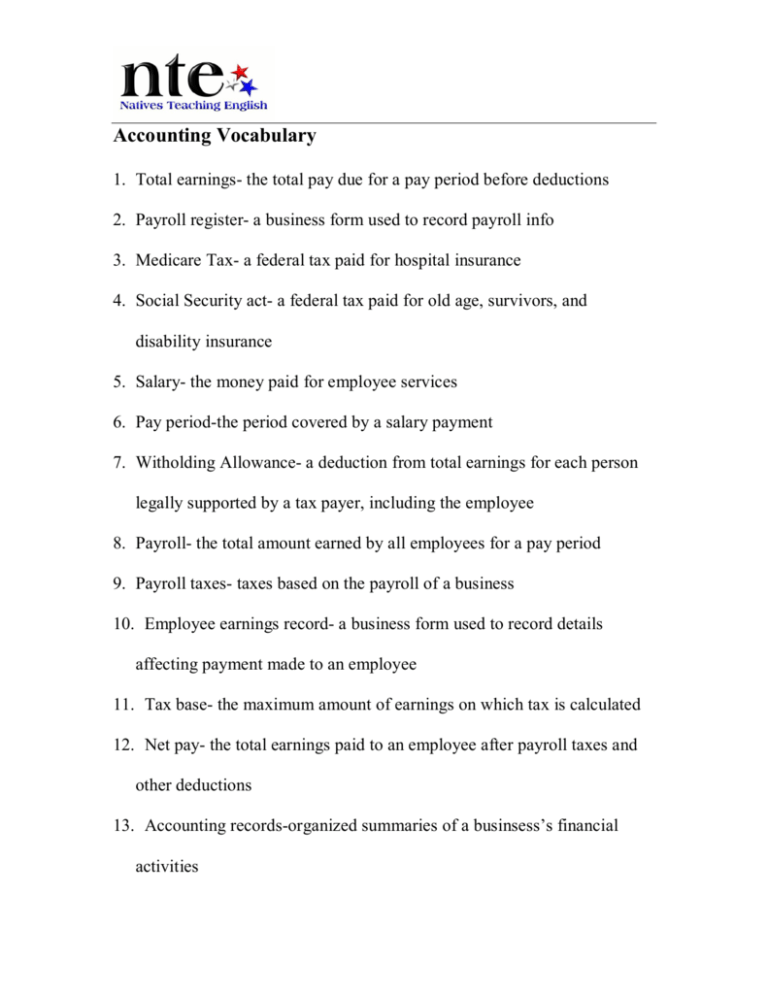
Accounting Vocabulary 1. Total earnings- the total pay due for a pay period before deductions 2. Payroll register- a business form used to record payroll info 3. Medicare Tax- a federal tax paid for hospital insurance 4. Social Security act- a federal tax paid for old age, survivors, and disability insurance 5. Salary- the money paid for employee services 6. Pay period-the period covered by a salary payment 7. Witholding Allowance- a deduction from total earnings for each person legally supported by a tax payer, including the employee 8. Payroll- the total amount earned by all employees for a pay period 9. Payroll taxes- taxes based on the payroll of a business 10. Employee earnings record- a business form used to record details affecting payment made to an employee 11. Tax base- the maximum amount of earnings on which tax is calculated 12. Net pay- the total earnings paid to an employee after payroll taxes and other deductions 13. Accounting records-organized summaries of a businsess’s financial activities 14. Withdrawls- assets out of a business for the owner’s personal use 15. Accounting System- a planned process for proving financial information that will be useful to management 16. account Number- the number assigned to an account 17. Service Business- a business that performs for free 18. Accounting- planning, recording, analyzing, and interpreting financial information 19. revenue- an increase in owner’s equity resulting from the operation of a business 20. equites- financial rights to the assets of a business 21. liability- an amount owed by a business 22. T acount- an accounting device used to analyze transactions 23. Owner’s Equity-the amount remaining after the value of all liabilites is subtracted from the value of all assets 24. Assets- anything of value that is owned 25. Blank Endorsement- only endorser’s signature 26. Postdated Check- check with a future date on it 27. Correcting entry- a journal made to correct an error in the ledger 28. Ledger- a group of accounts 29. General Ledger-a ledger that contains all accounts needed to prepare financial statements 30. Entry- information for each transaction recorded in a journal 31. Account balance- the amount in an account 32. Sales invoice- an invoice used as a source document for recording a sale on account 33. Journalizing- recording transactions in a journal 34. Accounting Equations- and equation showing the relationship among assets, liabilities, and owner’s equity 35. Endorsement- a signature or stamp on the back of a check transferring ownership 36. Checking account- a bank account from which payment can be ordered 37. Electronic funds transfer- a computerized cash payments system that uses electronic impulses to transfer funds 38. Debit card- a bank card that, when making purchases automatically deducts the amount of the purchase from the checking account of the card holder 39. Chart of accounts- a list of accounts used by a business 40. Restrictive endorsement- an endorsement restricting further transfer of a check’s ownership 41. Double entry accounting- the recording of debit and credit parts of a transaction 42. Proving Cash- determining that the amount of cash agrees with the balance of the cash account in the accounting records 43. Credit- an amount recorded on the right side of a T account 44. Normal balance- the side of the account that is increased 45. Net income- the difference between total revenue and total expenses when total revenue is greater 46. Receipt- a business form giving written acknowledgement for cash received 47. Petty Cash- an amount of cash kept on hand and used for making small payments 48. Petty cash slip- a form showing proof a petty cash payment 49. Sales on Account- a sale for which cash will be recieved on a later date 50. Debit- an amount recorded on the left side of a T account 51. Check- a business form ordering a bank to pay cash from a bank account 52. Fiscal period- length of time for which a business summarizes and reports financial information 53. File maintenance- the procedure for arranging accounts in a general ledger, assigning account numbers, and keeping records current 54. Adjustments- changes recorded on a worksheet to update general ledger accounts at the end of a fiscal period 55. Capital- the account used to summarize the owner’s equity in a business 56. Memorandum- a form on which a brief message is written describing a transaction 57. Source Document- a business paper from which information is obtained for a journal entry 58. Posting- transferring information from a journal entry to a ledger account 59. Opening an Account- writing account title and number on the heading of an account 60. Balance sheet- a financial statement that reports assets, liabilities, and owner’s equity on a specific date 61. Bank statement- a report of deposits, withdrawls, and bank balances sent to a deposit by a bank 62. Special endorsement- endorsement indicating new owner of a check 63. Invoice- a form describing the good or services sold, the quantity and the price 64. General Journal- a journal with 2 amount columns in which all kinds of entries can be recorded 65. Worksheet- a columnar accounting form used to summarize the general ledger information needed to prepare financial statements 66. Component percentage- percentage relationship between one financial statement item and the total that includes that item 67. Net loss- the difference between total revenue and total expenses when total expenses is greater 68. Trial Balance- a proof of the equality of debits and credits a general ledger 69. Journal- a form for recording transactions in chronological order 70. Income Statement- a financial statement showing the revenue and expenses for a fiscal period 71. Closing entries- journal entries used to prepare temporary accounts for a new fiscal period 72. Special Amount Column- a journal amount column headed with an account title 73. Merchandising Business- business that purchases and sells goods 74. Purchase journal- a special journal used to record only purchases of merchandise on account 75. General Amount Column- a journal amount column that is not headed with an account title 76. Cost of Merchandise- the price a business pays for goods it purchases to sell 77. Vendor- a business form which merchandise is purchased or supplies or other assets are bought 78. Cash Payments Journal- a special journal used to record only cash payment transactions 79. Purchase invoice- an invoice used as a source document for recording a purchase on account transaction 80. Mark up- the amount added to the cost of merchandise to establish the selling price 81. Wholesale merchandising business- a business that buys and sells merchandise to retail merchandising businesses 82. Merchandise- goods that merchandising business purchases to sell 83. Retail merchandising- a merchandising business that sells to those who use or consume the goods 84. Partner- each member of a partnership 85. Partnership- business which 2 or more persons combine assets 86. Post closing trial balance- a trial balance prepared after the closing entries are posted 87. Temporary accounts- accounts used to accumulate in for until its transferred to the owner’s capital account 88. Permanent accounts- accounts used to accumulate info from one fiscal period to the next 89. Adjusting entries- journal recorded to update general ledger accounts at the end of a fiscal period 90. Expense- a decrease in owner’s equity resulting from the operation of a business 91. Account- a record summarizing all the information pertaining to a single item in the accounting equation 92. Transaction- a business activity that changes assets, liabilities, or OE 93. Account Title- the name given to an account 94. Proprietorship- a business owned by one person 95. Dishonored check- a check bank refuses to pay
